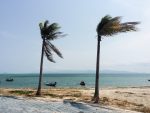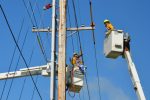As Hurricane Ian hit the Florida peninsula last week, college students, especially first-time ones, had to confront their fears and unanswered questions about hurricane preparation, safety and school.
Causing much damage in the southwest and northeast regions of Florida, Hurricane Ian displaced many people after the storm flooded entire communities and eroded the foundations of large areas of land. The specific regions of Sanibel Island, Fort Myers, Orlando and Daytona Beach were some of the places in Florida that were severely impacted by the hurricane.
School communities such as the University of Central Florida (UCF) and Bethune-Cookman University (BCU) experienced continued closures after the hurricane exited the Florida peninsula. The shutdowns resulted from the flooding of off-campus housing communities at UCF and the gruesome on-campus damage at BCU. UCF officially opened back up the following Tuesday, though university officials initially intended for the school to reopen on Monday instead. BCU had to close for an extended length of time as the university assessed damages to the campus and cleared out debris.
On the Monday before Hurricane Ian was expected to hit, many other colleges throughout the peninsula closed. Among the schools listed were Florida State University, Florida A&M University, the University of Florida and the University of South Florida. Students had about a week to prepare and gain their bearings for the incoming storm.
Many colleges advised their students to take safety precautions as they got ready for the storm. Some of the measures included an evacuation plan, storm shelter options, access to free cases of water and information about securing food in the case of power outages or flooding.
During a hurricane, students have options. They may choose to stay and endure the storm, evacuate to their hometowns or evacuate to a safer area in the region. If students remain in their college towns, they should prepare for the worst-case scenario. Students are advised to prioritize water sources and buy canned foods in case the power goes out.
In an article by AccuWeather, experts recommend college students charge all of their technology and obtain backup chargers, stock up on non-perishables and bottled water, and gather batteries, flashlights and a wireless radio before a hurricane. They should also make lists of important emergency contacts, secure a first aid kit, gather all sanitary and personal hygiene products and do laundry ahead of time. When it comes to evacuating, AccuWeather suggests students have a plan: They should inform their families of the situation, fill up the gas tank, withdraw some cash from the bank and keep important documents and valuables on hand. Through the different methods of preparation listed, students should be able to safely endure a hurricane at college.
With many schools in the Florida peninsula taking almost a week off of classes, students have had a lot of free time. During the unexpected break, there was a multitude of activities students could do. Some attended parties while others rested and caught up on some much-needed sleep. There were also students who took the time to complete missing assignments and make up schoolwork. Some students ventured into new opportunities, such as starting personal projects like a student-run PR firm or contributing to other avenues to benefit their futures. Some of the career development activities students engaged in included looking for jobs, searching for internships and planning for graduation.
As students in the southwestern region of Florida began to prepare for the hurricane, the trajectory of the storm took a turn. Initially, Hurricane Ian was expected to hit Tampa and the western coast of Florida the hardest. As the week went along, students and residents saw its trajectory change and watched as the hurricane tracker moved inward. When Hurricane Ian made landfall, Fort Myers suffered the largest blow.
Hurricanes themselves are tricky to predict as well as track. The Global Forecast System (GFS) used to track Hurricane Ian gave the least accurate prediction, expecting the hurricane to initially hit the northern part of Florida and the Florida Panhandle. Other GFS models were also not entirely accurate to Hurricane Ian’s eventual path, and the models were ever-changing as the week went by.
Due to the unpredictable nature of a hurricane, it is always better to be safer than sorry when it comes to preparation. Though Hurricane Ian didn’t touch the northern panhandle, many college students evacuated the area and began getting ready. Stores ran out of bottles of water, and gas stations ran out of gas. There were long lines, and the regions were filled with chaos as different communities began to prepare for the worst.
Hurricane Ian left a devastating impact on multiple communities in Florida and beyond. The hurricane turned into a tropical storm and hit areas in South Carolina and Georgia. Students in the surrounding Southern states also experienced school closures due to the storm, but not to the magnitude of students in Florida. Cuba was also negatively impacted.
According to AP News, Hurricane Ian is the second-deadliest storm to hit the mainland U.S. in the 21st century. It has left about 100 people dead so far, with most of the casualties occurring in Florida. Many people are still considered missing as rescuers continue to look for victims in the hurricane’s aftermath.
Named a Category 4 storm, Hurricane Ian reached winds of up to 150 mph. According to Gov. Ron DeSantis, there have been 2,500 people rescued. There have also been 2.5 million power outages in the state of Florida and 13 million power outages overall.
With long-lasting damage to the Florida peninsula, Hurricane Ian gave the state’s residents a look into the unexpectedness of a hurricane. Many college students were impacted by the storm and had to prepare for the worst. Though they received some days off from school, students had to deal with the stress and anxiety that accompany a hurricane. Following Hurricane Ian, the state of Florida continues to deal with the aftermath of the storm while most students resume their normal school routines and continue with the rest of the fall semester.
















